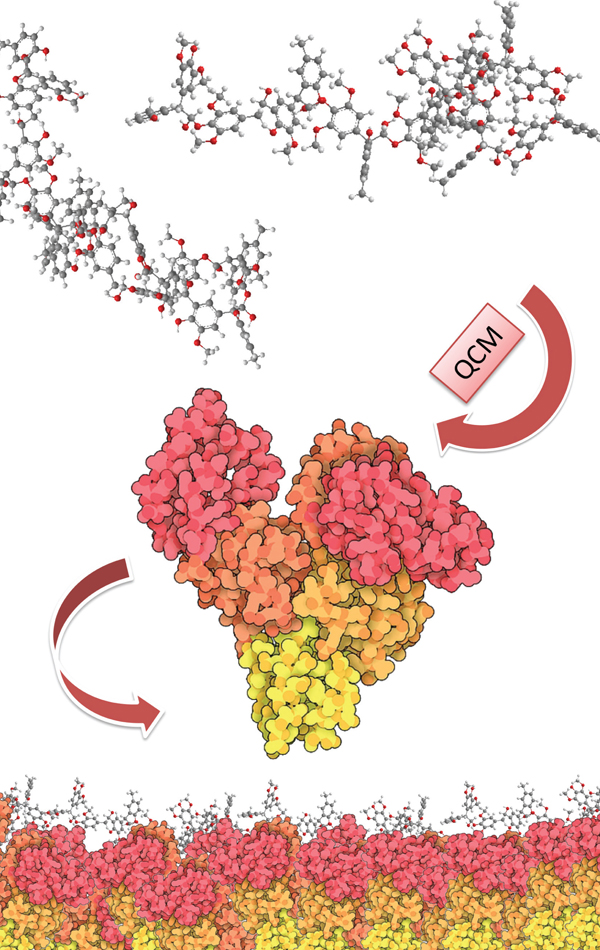| |
 · www.tappi.org
· www.tappi.org
· Subscribe
to Ahead of the Curve
· Newsletters
· Ahead
of the Curve archived issues
· Contact
the Editor

|
|
|
|
Lignin: Nature's versatile polymer as a potent chemical platform for 21st century challenges
(This article is excerpted from the January, 2019 issue of TAPPI Journal. View the full issue here.)
 Phenomenological depiction of quartz crystal microbalance (QCM)-based probing of the absorption of lignin model compounds to proteins. The ball and stick structures of either Masson pine or poplar lignophenol (LC) models are shown to adsorb to bovine serum albumin (BSA) protein. Artwork conceived and designed by Lulu Zhu, an M.Sc. student at Nanjing Forestry University, PR China, and co-author of the research mentioned here Phenomenological depiction of quartz crystal microbalance (QCM)-based probing of the absorption of lignin model compounds to proteins. The ball and stick structures of either Masson pine or poplar lignophenol (LC) models are shown to adsorb to bovine serum albumin (BSA) protein. Artwork conceived and designed by Lulu Zhu, an M.Sc. student at Nanjing Forestry University, PR China, and co-author of the research mentioned here
The rise in the global human population and concurrent spike in industrialization continue to lead to increased consumption of fossil fuels—an event with unfortunate and inevitable accompanying environmental burdens. Lignocellulosic biomass, a naturally abundant, ubiquitous, and renewable resource, has long been touted to sustainably replace fossil fuels as a materials and energy feedstock. However, its major constituent—cellulose—lies locked within an amorphous polymeric glue known as lignin whose principal function is to accommodate voids in the plant/woody cell wall. Lignin is a large portion of the secondary cell wall that displays a highly heterogeneous and amorphous molecular character endowing it with the dubious distinction of being virtually irrelevant for high-value applications.
Nevertheless, lignin exhibits numerous attractive properties, such as high carbon content, high thermal stability, biodegradability, antioxidative properties, and favorable stiffness. These advantages have recently motivated an emerging bioeconomy community interest in valorizing it. Despite its enormous potential, lignin is not fully utilized, and only a small percentage—less than 2 percent—of the approximately 70 million tons of lignin produced in the pulp and paper industry is employed in high value applications like concrete additives, stabilizing agents, dispersants, and surfactants. The remainder is normally incinerated for fuel value.
In truth, the complex and random structures of lignin pose serious challenges in any considerations for valorization because its native structure depends strongly on biogenics, i.e., plant species and local and seasonal variations. Importantly, pretreatment or pulping performed on lignocellulose causes extensive changes in the original structure. Indeed, isolated technical lignin likely possesses quite a different chemical connectivity than that of original lignin. Fortunately, nowadays, much is known about the structural features of native and, to a lesser extent, technical lignin. Such structural information offers a very useful guide for the design of valorization strategies. Because lignin has not attained its full valorization potential and therefore warrants further attention, it is exciting to witness a renaissance in its investigation by the scientific community as seen by the proliferation of work over the last five years.
A Showcase for Lignin's Versatility
The authors of this editorial served as guest editors for the January, 2019 issue of TAPPI Journal, the association's flagship research publication (a monthly electronic journal provided free to TAPPI Members.) The selections for this special issue highlight fundamental as well as applied aspects of lignin research.
Among the fundamental efforts showcased, researchers demonstrated that, after specific phase separation of poplar and Masson pine lignin, structural characteristics with respect to functional units and types of linkages are more accurately identified. Remarkably, a very unusual application after this discovery was exploited in the field of biomedical applications, thereby addressing the grand challenge of human health. It was shown that adsorption differences to bovine serum albumin (BSA) exist that can be ascribed to various lignin functional units. Such a finding has enormous potential implications for use in enzyme assays, biomedical micro- and nano-device tagging, and fluorescence labeling.
It is our earnest hope that the selections in the special issue of TAPPI Journal will excite the broader emerging bioeconomy community to investigate the remarkable chemical and physical plasticity/tunability of lignin. Not only is lignin nature's most idiosyncratic space-accommodating biopolymer, but its biosynthesis is sufficiently unique to provide morphologies, structural motifs, and molecular weights that can be cleverly manipulated.
By continued intense exploration and multidisciplinary efforts within the unique playground of lignin, it may be possible to endow it with sufficiently advanced properties to tackle a number of the grand challenges of the 21st century.
About the authors:
Professor Lucian Lucia of North Carolina State University (NCSU) graduated from the University of Florida in the field of physical organic chemistry under the mentorship of Professor Kirk S. Schanze. He also worked as a post- doctoral fellow under the direction of Professor David G. Whitten at the NSF Center for Photoinduced Charge Transfer at the University of Rochester. He is now associate professor and director of The Laboratory of Soft Materials & Green Chemistry at NCSU in Raleigh, NC. His current work focuses on water purification, hydrogels, smart materials, and bacterial cellulose.
Professor Shiyu Fu graduated from South China University of Technology (SCUT) in the field of pulp and papermaking engineering. He worked as a postdoctoral fellow under the direction of Professor Lucian Lucia at the Georgia Institute of Technology. He is now professor and deputy director of State Key Laboratory of Pulp & Paper Engineering at SCUT in Guangzhou, PR China. His current work focuses on pulping, fiber modification, nanocellulose, and lignin applications.
For a modest investment of $174, receive more than US$ 1000 in benefits in return.
Visit www.tappi.org/join for more details. |
|




